Types of Bees
Question:
How many types of bees are there in the world?
Answer:
There are over 4,000 genera (types of bees) belonging to 7 bee families, and over 20,000 individual recorded species, but there are probably more species to be discovered. There are about 4,000 species of bee in the US, and over 250 species in Britain.
Exploring The Different Types Of Bees
All bees belong to the insect or Super-family 'Apoidea'. Apoidea also includes 'sphecoid wasps', from which bees are descended. You can read more about this on my link: are bees and wasps related?
Below is an introduction to 20 types (genera) of bees that you can look out for in your garden and local environment, including some you'll be familiar with, such as honey bees, bumble bees and leafcutters.
Most bees are solitary, though some are social to varying degrees.
20 Types Of Bee To Look Out For
Here are 20 types of bee (genera) for you to look out for in your garden and local environment.
Note that the appearance of individual species within each genus will vary.
1. Honey Bees (Family: Apidae) Genus - Apis
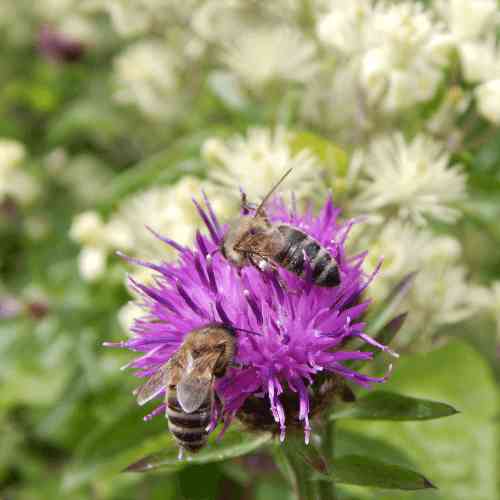 Honey bees foraging on knapweed
Honey bees foraging on knapweedHoney bees are eusocial bees, and live in large colonies often consisting of around 50,000 – 60,000 workers.
The Western or European Honey Bee, Apis Mellifera is one of the best-known species and is commonly kept by beekeepers in hives, who then harvest their honey. In the wild, they nest in tree trunks and natural caves and large crevices. They may sometimes make use of man-made structures, such as chimneys.
Honey bees are used extensively in crop pollination too, and along with other bees, they help to put food on our plates.
They are able to forage in cool temperatures when other bees are absent, and are very important for pollinating certain crops, such as almonds.
2. Bumble Bees (Family: Apidae) Genus - Bombus
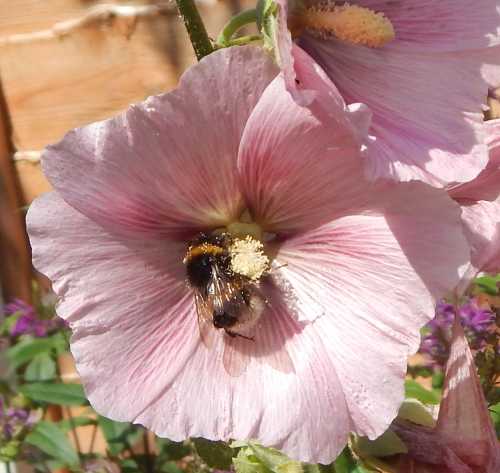 Bumble bee, possibly Bombus lucorum on hollyhock
Bumble bee, possibly Bombus lucorum on hollyhockBumble bee colonies are usually fairly small, from 50 to 400 workers, but usually around 120 to 200.
Most species are ‘primitively eusocial', but there are also parasite species, known as 'cuckoo bumble bees' which inhabit the nests of other bumble bee hosts.
Bumble bees are excellent pollinators of many kinds of flowers, and are a welcome and familiar site in gardens. Their efficiency as pollinators is partially down to their furry body, but also because they are some of the bees able to 'buzz pollinate'.
3. Leafcutter Bees (Family: Megachilidae)
Genus - Megachile
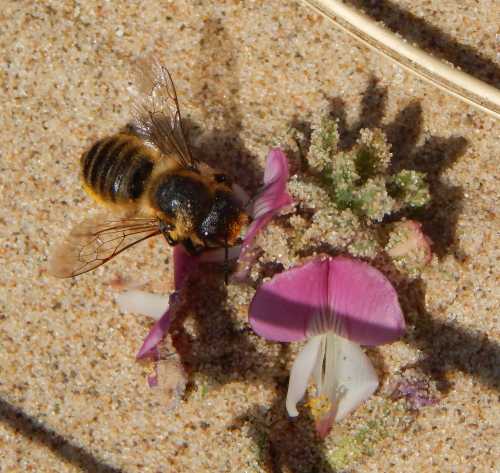 Coastal leaf cutter bee, Megachile maritima
Coastal leaf cutter bee, Megachile maritimaIf you're lucky, you may catch a glimpse of leafcutter bees snipping neat segments of leaf from a plant or bush, or perhaps making a nest in your bee hotel. You can watch videos of this activity on my page about leafcutter bees.
Leafcutter bees cut neat segments of leaf or petal with their jaws. They return this to the site of their nest, and use it for constructing their egg cells in existing crevices and hollow plant stems.
Leafcutter bees are common in gardens, but look out for them in other environments too!
Pictured above is the Coastal Leafcutter Bee, Megachile maritima.
4. Mason Bees (Family: Megachilidae) Genus - Osmia
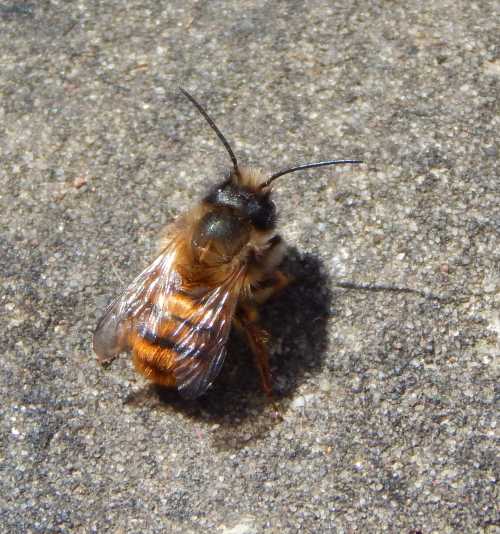 Red mason bee, Osmia bicornis
Red mason bee, Osmia bicornisMason bees make nests in crevices, sometimes in old mortar, or even empty snail shells.
Belonging to the genus Osmia, the name means 'odor', referring to the scent they use to mark their nest entrances.
Around 500 species of Osmia have been identified around the world.
Pictured above is the Red Mason Bee, Osmia bicornis.
5. Mining Bees (Family: Andrenidae) Genus - Andrena
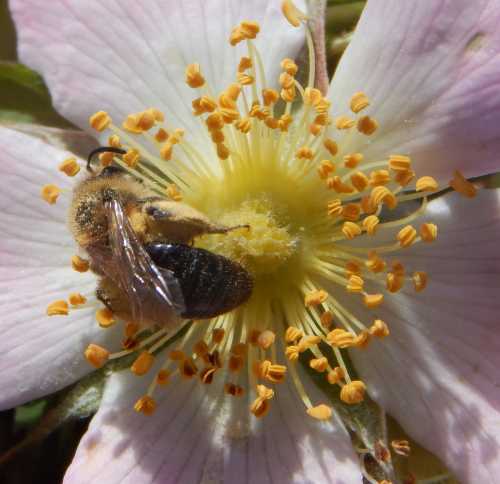 Painted mining bee, Andrena fucata, female
Painted mining bee, Andrena fucata, femaleMining bees belong to one of the largest families of bees, with around 1400 known species. Andrena comes from the Greek for 'buzzing insect'.
Females usually build nests quite close to each other. Andrena species are important for pollination of some key crops, such as blueberries, apples and cranberries.
From the name, you probably guessed that mining bees excavate tunnels and cells underground. If you're lucky, you may see evidence of them in your garden: little mounds of earth in lawns, borders, that look a bit like worm casts. In general, they seem to prefer sandy soil.
Pictured above is the Painted Mining Bee, Andrena fucata.
6. Large Carpenter Bees (Family: Apidae)
Genus - Xylocopa
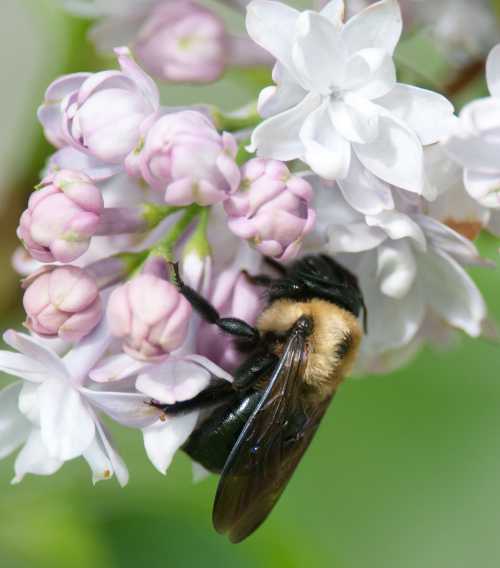 Eastern carpenter bee, Xylocopa virginica
Eastern carpenter bee, Xylocopa virginicaCarpenter bees are large, burly bees. More than 500 Xylocopa species are known worldwide. Species are found in tropical regions, in the USA, Canada, and Europe. They are known to buzz pollinate.
Xylocopa is Greek for 'wood worker', referring to the nest making habits of this species by chewing tunnels into wood.
The species pictured above is called an Eastern Carpenter Bee, Xylocopa virginica which is sometimes mistaken for a bumble bee when seen in gardens.
7. Plasterer Bees (Family: Colletidae)
Genus - Colletes
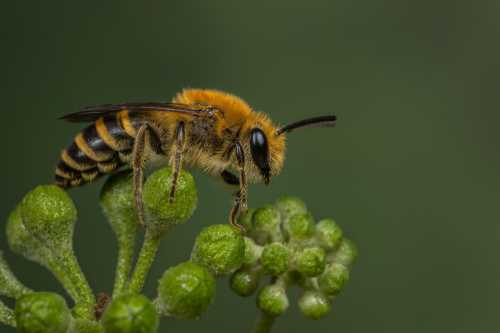 Ivy bee, Colletes hedera (male)
Ivy bee, Colletes hedera (male)Plasterer bees are also known as 'cellophane bees', and sometimes even 'polyester bees'. They are known for creating and lining their nests with a waterproof substance.
Pictured above is the Ivy Bee, Colletes hedera.
8. Wool Carder Bees (Family: Megachilidae)
Genus - Anthidium
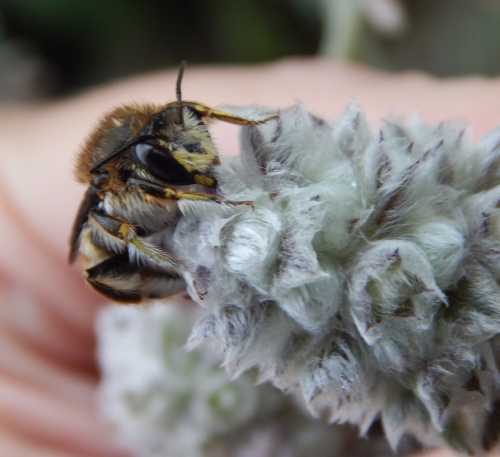 Wool carder bee
Wool carder beeThe gorgeous wool carder gathers hairs from plants, rolls them into a ball, and uses them to create its nest.
Some of these species can be mistaken for wasps because of their yellow and black body markings.
There are around 160 known species worldwide.
Pictured above is a Wool Carder Bee, Anthidium manicatum.
9. Flower Bees (Family: Apidae) Genus - Anthophora
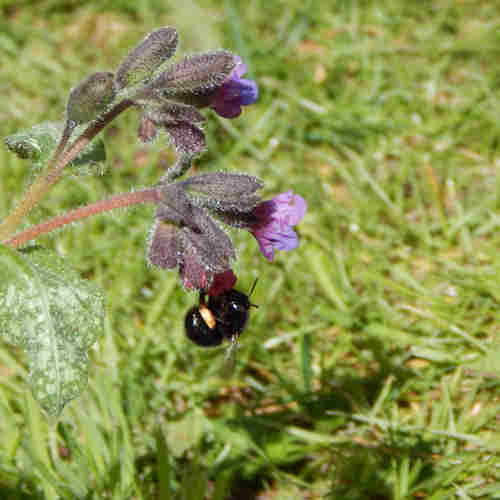 Female hairy-footed flower
Female hairy-footed flowerThe word Anthophora means 'flower bearer'. There are around 400 known flower bee species worldwide. These bees are able to buzz pollinate, and some will emerge in the cool weather to forage in early spring.
Above is a Hairy-Footed Flower Bee - Anthophora plumipes feeding on a very useful source of early spring food for bees - Pulmonaria.
10. Nomad Bees (Family: Apidae) Genus - Nomada
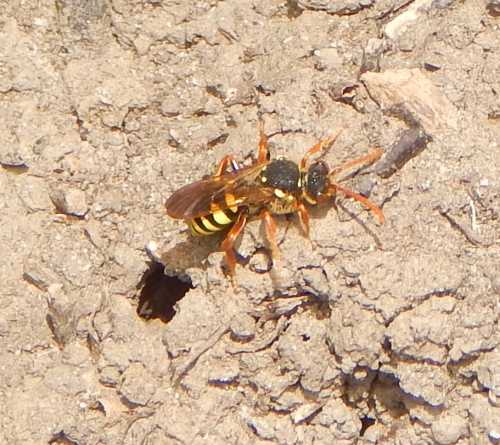 Nomad bee, Nomada goodeniana outside a potential host nest burrow
Nomad bee, Nomada goodeniana outside a potential host nest burrowNomad bees could easily be mistaken for small wasps. They are cleptoparasites, often attacking the nests of bees from the Andrena genus, but sometimes the nests of Colletes, Lasioglossum and Eucera, among others.
They are especially easy to spot when they are flying low around nest burrows of ground nesting bee species.
There are around 700 known species worldwide.
Pictured above is the Gooden's Nomad Bee, Nomada goodeniana.
11. Long-horned Bees (Family: Apidae)
Genus - Eucera
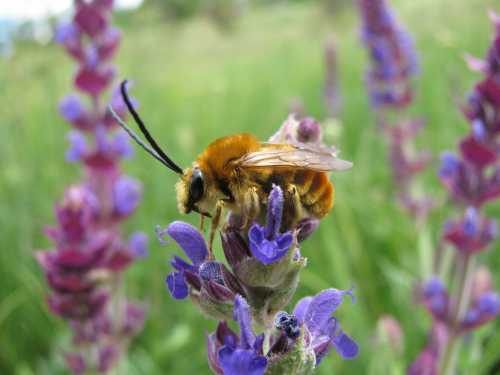 Long-horned bee, Eucera longicornis (male) on wild sage flowers
Long-horned bee, Eucera longicornis (male) on wild sage flowersLong-horned bees are beautiful! Eucera means 'well-horned' in Greek. The 'horns' refer to the long antennae present in the males. Around 400 species are known worldwide.
12. End-banded Furrow Bees (Family: Halictidae)
Genus - Halictus
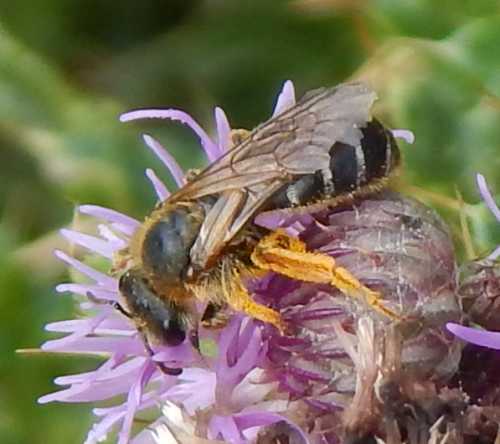 Orange-legged furrow bee on knapweed
Orange-legged furrow bee on knapweedOver 300 species of furrow bee have been described worldwide.
In some regions, various Halictus species are known to sip sweat from humans, and as a result, may be known as ‘sweat bees’ (along with species from the Lassioglossum genus, which also belong to the Halictidae family).
The Greek word Halictus is believed to originate from the Greek term for gathering or collecting.
These bees tend to have a distinctive striped appearance.
In terms of foraging, they are generalists. Look out for these charming bees foraging on wild flowers such as knapweed and thistles, or look to flowers from the Asteraceae family (daisy type flowers) in your garden.
Pictured above is an Orange-legged Furrow Bee.
13. Yellow-faced Bees (Family: Colletidae)
Genus Hyleaus
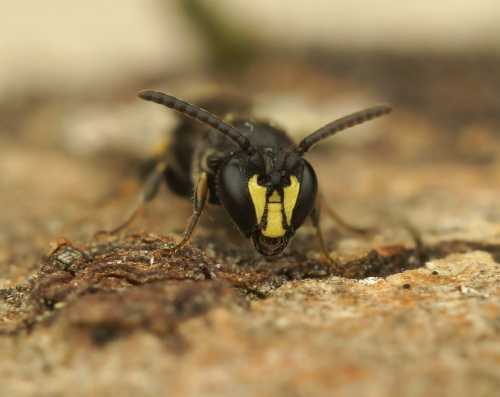 Common yellow-face bee, Hylaeus communis
Common yellow-face bee, Hylaeus communisYellow-faced bees are small, enchanting bees, and this is the only bee genera native to Hawaii.
They are found around the world, with approximately 50 species on mainland North America, and 12 species in the UK.
These bees line their nests with a silk-like substance, and you can watch them in action on my page about Yellow-faced bees.
14. Resin Bees (Family: Megachilidae)
Genus Heriades
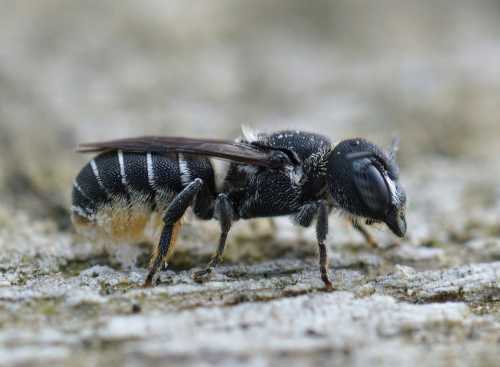 Female small resin bee, Heriades crenulatus
Female small resin bee, Heriades crenulatusThese small, blackish bees can easily be mistaken for little black flies. Look out for the hairy pollen brush on the abdomen (only present on the female) and the slight curve to the tip of the abdomen.
This species can be found in a variety of habitats across Europe, North and Central America, Japan, Asia, India parts of Africa and the Pacific Islands. They collect resins from trees - often pines, which are then used to construct nest cells.
Read about the foraging and nesting habits of Resin Bees.
15. Pantaloon Bees (Family: Melittidae)
Genus Dasypoda
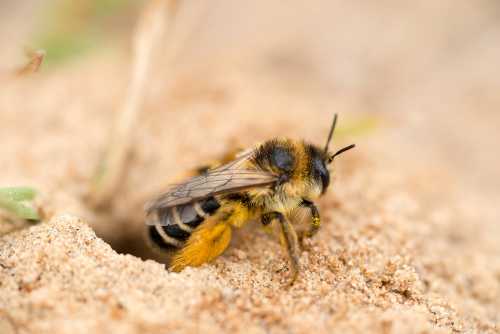 Pantaloon bee, Dasypoda hirtipes
Pantaloon bee, Dasypoda hirtipesThe females of these gorgeous bees have especially long pollen-collecting hairs on their rear legs.
They nest in sandy ground and may bee seen foraging on thistles, knapweeds and yellow composite flowers. Entomologist, Steven Falk notes that 30 species have been described, all from the Old World.
Above is the Pantaloon Bee, Dasypoda hirtipes.
16. Sharp-tail Bees (Family: Megachilidae)
Genus Coelioxys
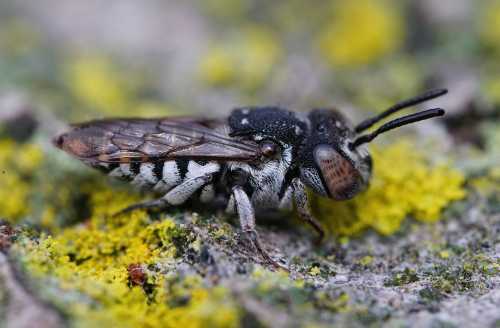 Female Short Sharptail bee Coelioxys afra
Female Short Sharptail bee Coelioxys afraLike honey bees, these species have hairy eyes, but unlike honey bees, Coelioxys are cleptoparasites. The females lay their eggs in the nests of host solitary bees, and their young eat the food stores intended for the offspring of the host.
Above is the female of the Short Sharp-tail Bee, Coelioxys afra. Read about Coelioxys - sharp-tail bees.
17. Small Carpenter Bees (Family: Apidae) Genus - Ceratina
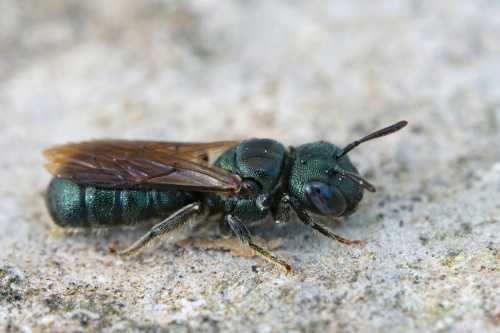 Little blue carpenter bee, Ceratina cyanea
Little blue carpenter bee, Ceratina cyaneaThese small to medium-sized bees are found on every continent apart from Antartica, and there are more than 350 Ceratina species worldwide.
They are related to the larger carpenter bees of the genus Xylocopa. These bees have a metallic sheen on their bodies, which are practically hairless.
They forage on a range of flowers.
Pictured above is the Little Blue Carpenter Bee, Ceratina cyanea.
18. Blood Bees (Family: Halictidae)
Genus - Sphecodes
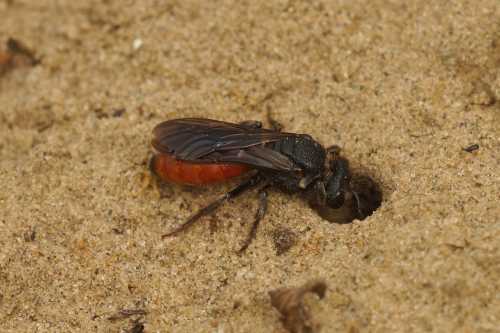 Sphecodes albilabris, giant blood bee
Sphecodes albilabris, giant blood beeThese cleptoparasitic bees have blood-red abdomens and target nests of ground-nesting species, in particular those of the Halictus, Andrena and Lassioglossum genera.
However, at first glance, they could easily be confused with non-parasitic species with similar red abdomens, such as the females of Andrena marginata, (the Small Scabious Mining Bee), or Andrena labiata (Red-girdled Mining Bee).
Pictured above is the Giant Blood Bee, Sphecodes albilabris.
Read and watch a short video about Blood Bees.
19. Oil-collecting Bees (Family: Melittidae)
Genus - Macropis
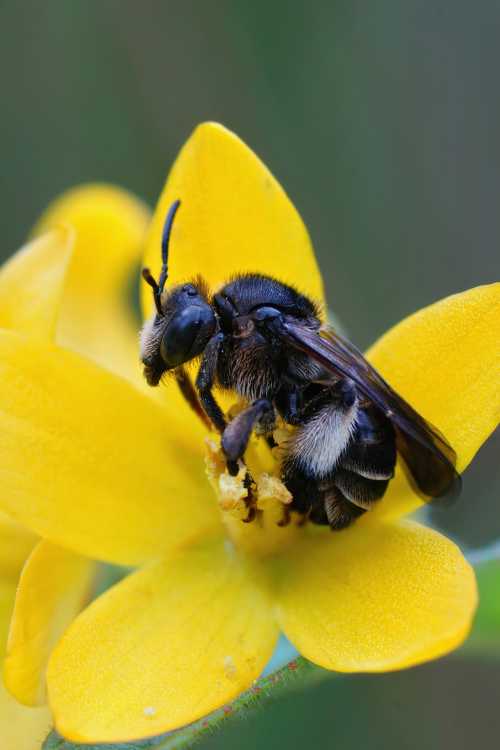 Yellow loosestrife bee, Macropis europaea, female
Yellow loosestrife bee, Macropis europaea, femaleThese bees are associated with Loosestrife (Lysimachia) flowers.
Macropis collect pollen and floral oils using the specially adapted hairs on the front and hind legs. The oil is used to waterproof their nests.
Pictured above is the Yellow-loosestrife Bee, Macropis europaea.
Learn more about oil-collecting bees, Macropis.
20. Base-banded Furrow Bees (Family: Halictidae)
Genus - Lasioglossum
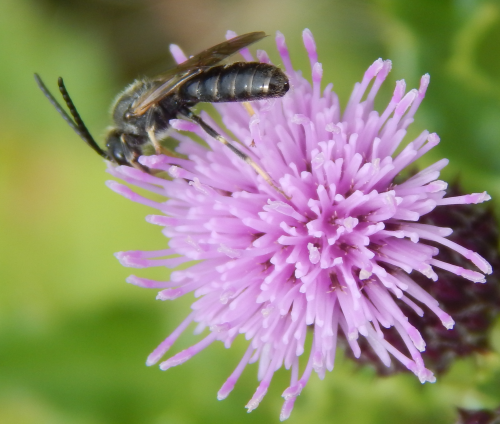 Chalk furrow bee, Lasioglossum fulvicorne, chalk furrow bee (male)
Chalk furrow bee, Lasioglossum fulvicorne, chalk furrow bee (male)Lasioglossum is the world's largest genus of bees, with over 1,700 described species, according to entomologist, Steven Falk.
In appearance, they range from tiny, to about the size of a honey bee. Most species nest underground in the soil.
In some regions of the world, Lasioglossum species are known to collect human sweat, and are given the name 'Sweat Bees'.
Identifying Bees
Identification can at times, be difficult, and more than once I have observed bee experts debate the identification of species when presented with a photograph.
My bee identification tips may help you distinguish a bee from a fly or wasp.
If you want to know where bees fit into the grand scheme of things, then take a look at this fun link about the insect order 'Hymenoptera', which actually includes other types of insects, including ants. I hope you like the drawings!
References
- Michener, Charles D. (2000). The Bees of the World. Johns Hopkins University Press.
- Danforth, B. N.; Sipes, S.; Fang, J.; Brady, S. G. (October 2006). "The history of early bee diversification based on five genes plus morphology". PNAS. 103 (41): 15118–15123.
- Field Guide to the Bees of Great Britain and Ireland by Steven Falk.
- The Bees In Your Backyard - A Guide To North America's bees by Joseph S Wilson and Olivia Messenger Carril.
